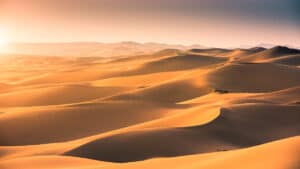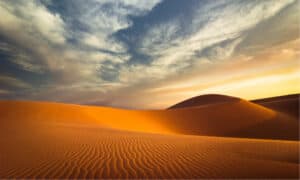The Kalahari Desert is a massive expanse of semi-arid savannah land located in Southern Africa. Although it’s considered one of Africa’s most popular deserts and the second-largest desert on the continent, the Kalahari is technically not a desert because it receives too much rainfall to be classified as one. However, the massive arid land which straddles three different countries is still classified as a desert because it lacks surface precipitation.
Location & Name
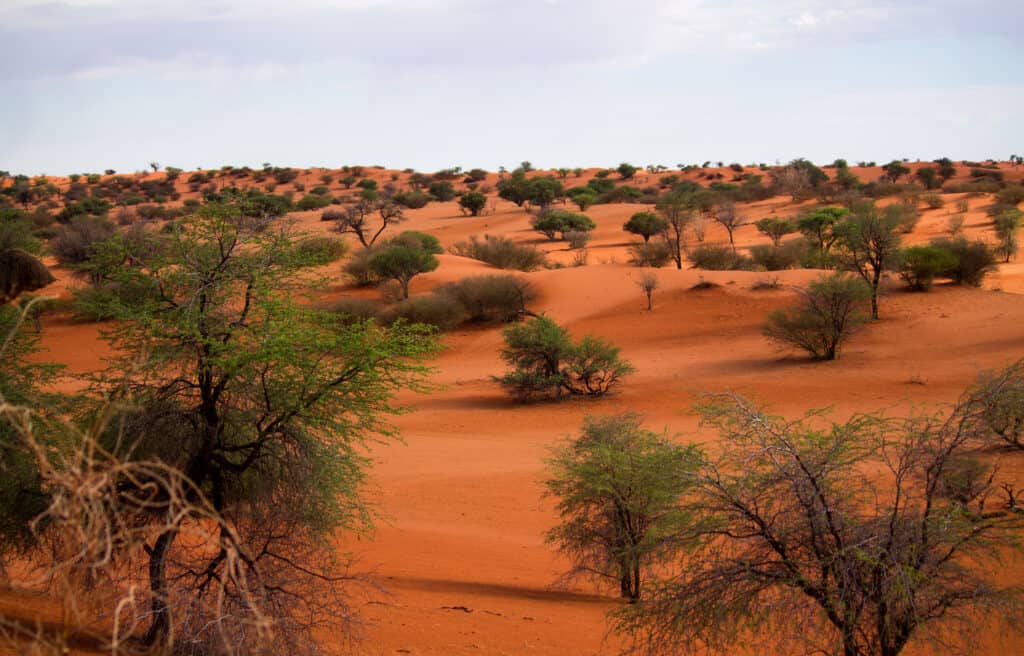
Although not technically a desert, the Kalahari desert is classified as one due to its lack of surface precipitation.
©iStock.com/Benedetta Ceccanti
The name Kalahari is derived from the word Kgala or Kgalagadi. These are words in the local Tswana language that translate as “the great thirst” and “the waterless place,” respectively. This is a reference to the fact that the vast desert is covered predominantly by red dunes with no permanent surface water.
The large basin-like plain is located in the interior plateau of Southern Africa. It covers almost the entire country of Botswana, the eastern third of Namibia, and the Northern edge of the Cape Province in South Africa. In the Southwest, the desert transitions into a coastal desert known as the Namib Desert.
Kalahari Desert – Size
The Kalahari desert is the second largest desert in Africa. It covers a land area of about 360,000 square miles (930,000 square kilometers). At the longest point, the Kalahari’s north-south length is approximately 1,000 miles (1,600 kilometers). Similarly, at its widest point, the desert covers an east-west distance of about 600 miles.
The surrounding Kalahari Basin extends even further than the desert itself. It extends into Botswana, Namibia, and South Africa. The basin also covers parts of Angola, Zimbabwe, and Zambia. The basin is about 970,000 sq mi (2,500,000 square kilometers)
Geography
Going by the strictest definition of the word, the Kalahari would not qualify as a desert. This is because it receives more precipitation than a desert is meant to get. The driest parts of this desert receive between 110–200 mm (4.3–7.9 in) of rainfall annually. The wettest areas receive more than 500 millimeters (20 in) of rain annually.
By definition, for an area to qualify as a desert, it has to receive less than 0.10 inches (25mm) of rain annually. Therefore, by this definition, the Kalahari would be more of a semi-desert than an actual desert. However, the Kalahari is still a very dry location with no permanent surface water. The lack of surface precipitation is due to the fact that the evaporation rate in this desert is twice as high as the precipitation rate. Therefore, based on these criteria, the southwestern half of the Kalahari would qualify as a desert.
It is important to note that not all parts of the Kalahari experience more evaporation than precipitation. In the northeastern portion of the desert, for instance, there’s more rainfall than evaporation. Still, this area lacks any surface water mainly because of the nature of the soil. Wherever rain hits the desert floor seeps straight into the loose sand, leaving the surface completely dry and parched.
Physical Features
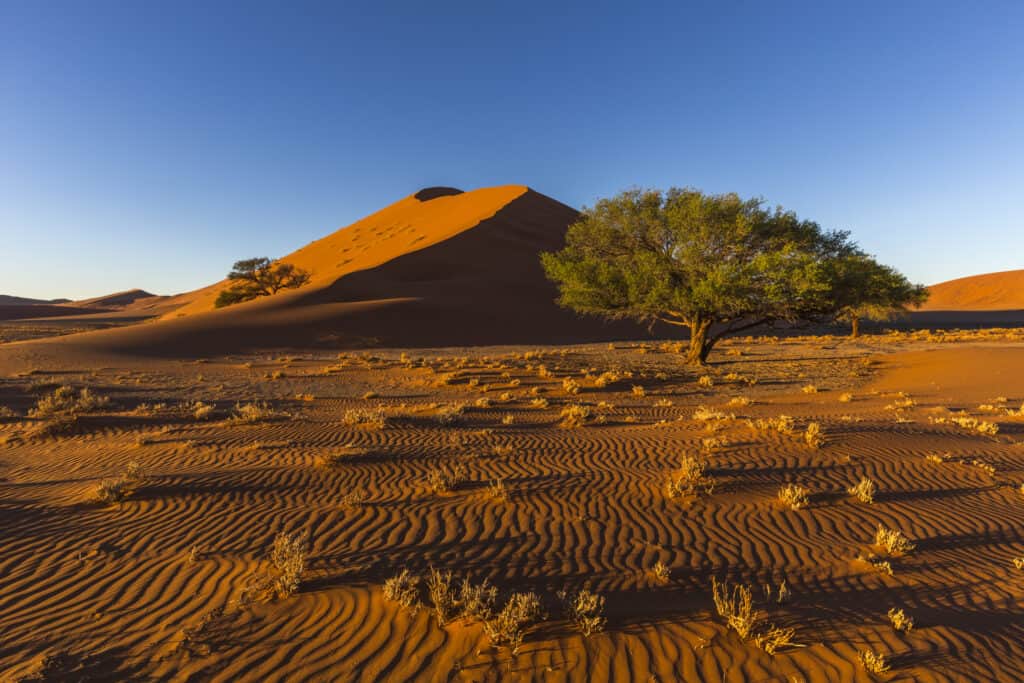
Most of the Kalahari Desert is a sand-covered plain, but there are a few low, vertical-walled hills and sand dunes.
©iStock.com/HannesThirion
Most of the surface of the Kalahari Desert lacks physical features. The entire area is a vast sand-covered plain. The average elevation in the desert is about 900 meters (3000 ft) above sea level. Due to the abundance of red sand, solid bedrock is hardly exposed in this desert. Only a few low, vertical-walled hills (called kopjes) show solid rock exposures, and these are quite rare. In addition, other physical features you’ll see in the Kalahari include sand sheets, vleis (or pans), and longitudinal sand dunes.
The sand sheets are more common in the eastern part of the desert, and they appear to be of mixed origin. Some of the sheets are of fluvial origin, meaning they were deposited at a time when the region received more precipitation. However, a large number of these sheets were wind-deposited. The red color of the desert sand is a result of a thin layer of iron oxide coating the sand grains. In some places, the depth of the sand above the bedrock exceeds 200 feet.
On the western end of the desert, sand dunes are more common. These dunes have an average length of 1 mile and may be up to 100 feet wide. The dunes vary in height between 20 to 200 feet. There are broad parallel depressions between each dune that serve as passageways for people traveling through the desert.
The pans or vleis are dry lakes formed by temporary streams. Numerous vleis exist within the Kalahari desert and serve as evidence of a period where the region received greater precipitation than it did today. These flat surfaces typically consist of whitish sand composed of calcium minerals that have been hardened by soluble minerals.
Kalahari Desert Climate
The climate of the Kalahari is subtropical. The region has an average annual temperature of 18 °C, while the peak temperature can be up to 40 °C or more on some days. In the coldest months, the mean temperature is typically less than 18 °C. Although daily temperatures may reach peaks of up to 45 °C in the warmest months, the average temperature rarely exceeds 29 °C.
Kalahari Desert – Wildlife
The Kalahari Desert supports more plant and animal life than many of the popular true deserts do. This is expected since the area has low aridity compared to the “true deserts.” Even the nearby Namib desert has a lower flora and fauna diversity compared to the Kalahari.
Plant Life of the Kalahari
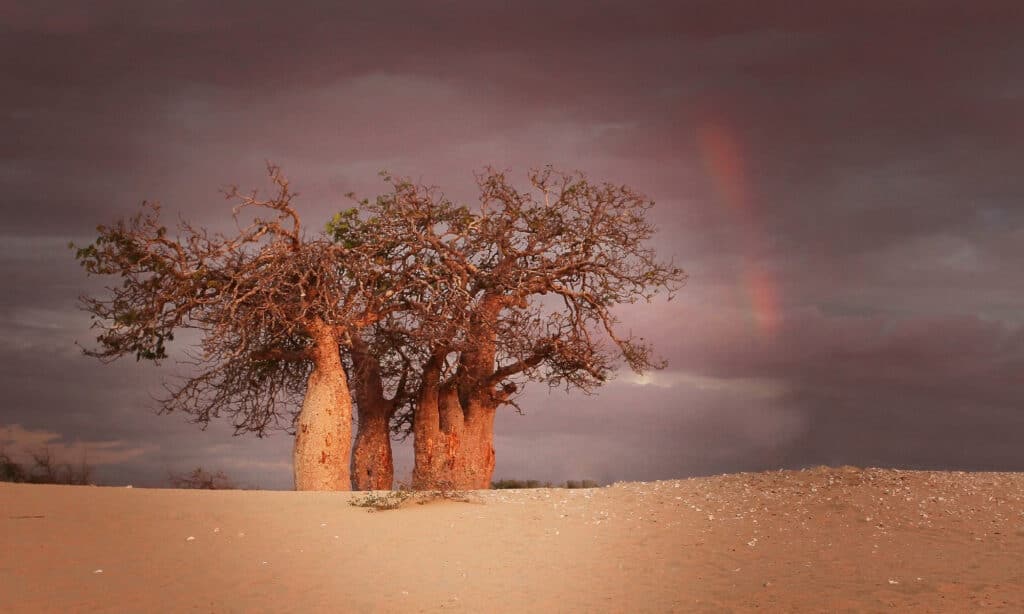
Baobab trees exist in the Kalahari also with other evergreen and deciduous vegetation.
©iStock.com/gydyt0jas
Shallow-rooted perennial plants cannot survive in the Kalahari due to the deep sand covers. However, annual plants that can grow rapidly often spring up when rains are abundant. On a few occasions, they may be able to endure until the next rainy season arrives. The more permanent plant life in the Kalahari includes trees capable of developing deep roots.
In the southwestern end of the Kalahari, where precipitation is low, there are a few trees present. Drought-tolerant shrubs and grasses are more common in this part of the desert. The central part of the desert gets more precipitation, and they have more scattered trees (especially Acacia) as well as numerous shrubs and grasses. The northern edge of the desert transitions into a lush open woodland with palm trees and thorn bushes. There are also areas with evergreen, deciduous vegetation, including baobab trees.
Animal Life of the Kalahari
Given the abundance of plant life, the Kalahari Desert expectedly has a rich fauna. The diversity of animal life increases as you go from the south to the northern parts of the desert. Despite the absence of surface water, at the south end of the desert, you’ll still find herds of animals like the springbok, hartebeest, and gnu (or wildebeest). You’ll also find smaller animal species such as the kudu, steenbok, and duiker, among others.
The northern part of the Kalahari is even more diverse. You’ll find a strong population of giraffes, antelopes, zebras, buffalo, and even elephants. Predator species such as hunting dogs, foxes, cheetahs, and lions exist here as well. Smaller animals like badgers, hare, porcupines, and many other small rodents also live in the Kalahari. There’s also an abundance of snakes, lizards, and bird species that call this semi-arid desertland home.
Up Next
The 9 Deadliest and Most Dangerous Deserts on Earth
7 Hottest Deserts on Earth are Absurdly Warm
Discover 6 Desert Dwelling Spiders
The photo featured at the top of this post is © Dmitry Pichugin/Shutterstock.com
Sources
- Wikipedia, Available here: https://en.wikipedia.org/wiki/Kalahari_Desert
- Britannica, Available here: https://www.britannica.com/place/Kalahari-Desert
- Safari Bookings, Available here: https://www.safaribookings.com/blog/10-interesting-kalahari-desert-facts
- Africa Wanderlust, Available here: https://africawanderlust.com/destinations/kalahari-desert/
Thank you for reading! Have some feedback for us? Contact the AZ Animals editorial team.




